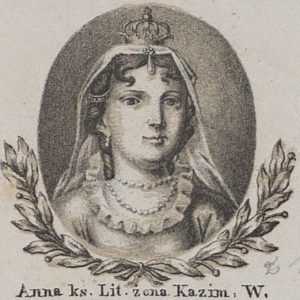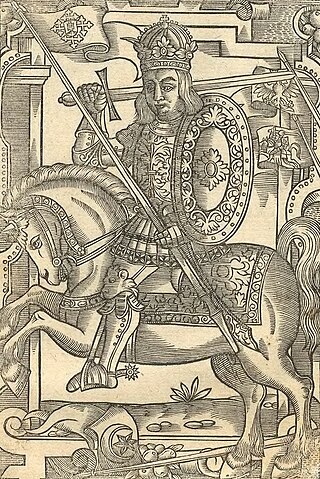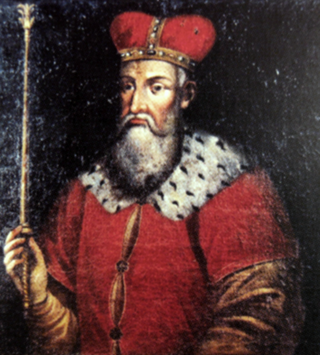Related Research Articles

Aldona was Queen consort of Poland (1333–1339), and a princess of the Grand Duchy of Lithuania. She was the daughter of Gediminas, Grand Duke of Lithuania.

Algirdas was the Grand Duke of Lithuania from 1345 to 1377. With the help of his brother Kęstutis he created an empire stretching from the present Baltic states to the Black Sea and to within 80 kilometres of Moscow.

The House of Gediminid or simply the Gediminids were a dynasty of monarchs in the Grand Duchy of Lithuania that reigned from the 14th to the 16th century. A cadet branch of this family, known as the Jagiellonian dynasty, reigned also in the Kingdom of Poland, Kingdom of Hungary and Kingdom of Bohemia. Several other branches ranked among the leading aristocratic dynasties of Russia and Poland into recent times.
The Battle on the Irpin River is a semi-legendary battle between the armies of the Grand Duchy of Lithuania and Principality of Kiev. According to the story, Gediminas, the Grand Duke of Lithuania, conquered Volhynia before turning his attention to Kyiv. He was opposed by Prince Stanislav of Kiev allied with the Principality of Pereyaslavl and Bryansk. Lithuanians achieved a great victory and extended their influence to Kyiv. There are no contemporary sources attesting to the battle. It is known only from late and generally unreliable Lithuanian Chronicles. Therefore, historians disagree whether it was an actual battle in the early 1320s or a fictional story invented by later scribes. Lithuanians gained full control of the city only in 1362 after the Battle of Blue Waters against the Golden Horde.
Karijotas or Koriat was the Duke of Navahrudak and Vaŭkavysk, one of the sons of Gediminas, Grand Duke of Lithuania.
Jaunė was daughter of Prince Ivan of Polatsk and wife of Gediminas, the Grand Duke of Lithuania (1316–1341). She is mentioned in written sources only once – the Bychowiec Chronicle, a late and unreliable source. Therefore, some historians cast a serious doubt on her existence, but modern reference works still widely cite her as the ancestress of the Gediminids dynasty.
The Palemonids were a legendary dynasty of Grand Dukes of the Grand Duchy of Lithuania. The legend was born in the 15th or 16th century as proof that Lithuanians and the Grand Duchy are of Roman origins. Already Jan Długosz (1415–1480) wrote that the Lithuanians were of Roman origin, but did not provide any proof. The legend is first recorded in the second edition of the Lithuanian Chronicle produced in the 1530s. At the time the Grand Duchy of Lithuania was quarrelling with the Kingdom of Poland, rejecting the claims that Poland had civilized the pagan and barbaric Lithuania. The Lithuanian nobility felt a need for the ruling dynasty to show upstanding origins, as the only available chronicles at the time were written by the Teutonic Knights, a long-standing enemy, and depicted Gediminas, ancestor of the Gediminids dynasty, as a hostler of Vytenis.

The House of Mindaugas was the first royal family of Grand Duchy of Lithuania, centered on Mindaugas, the first known and undoubted sovereign of Lithuania. He was crowned as King of Lithuania in 1253 and assassinated ten years later. His known family relations end with children; there is no data on his great-grandchildren or any relations with the Gediminids, a dynasty of sovereigns of Lithuania and Poland that started with Butigeidis ca. 1285 and ended with Sigismund II Augustus in 1572.
Edvardas Gudavičius was a Lithuanian historian. He was known as one of the best historians in Lithuania specializing in the early history of Grand Duchy of Lithuania and is an author of many publications.

The family of Gediminas is a group of family members of Gediminas, Grand Duke of Lithuania, who interacted in the 14th century. The family included the siblings, children, and grandchildren of the Grand Duke and played the pivotal role in the history of Lithuania for the period as the Lithuanian nobility had not yet acquired its influence. Gediminas was also the forefather of the Gediminid dynasty, which ruled the Grand Duchy of Lithuania from 1310s or 1280s to 1572.

De moribus tartarorum, lituanorum et moscorum is a 16th-century Latin treatise by Michalo Lituanus. The work, which was originally dedicated to King of Poland and Grand Duke of Lithuania Sigismund II Augustus, survived only in ten fragments that were first published in 1615 by Johann Jacob Grasser in Basel, Switzerland.
The Metropolis of Lithuania was a metropolis of the Ecumenical Patriarchate of Constantinople in the Eastern Orthodox Church. It was erected on the territory of the Grand Duchy of Lithuania between 1315 and 1317. It was disestablished in 1371. The seat (cathedra) of the metropolis was initially in Navahrudak. It had only two metropolitan bishops. The establishment took place in the aftermath of the Mongol invasion of Kievan Rus' which was exploited by the rulers of Lithuania to greatly expand their territory. To help legitimize their annexations and to bind their new subjects more closely to the state, the royal powers favoured the erection of a metropolis for the inhabitants of the Grand Principality. To avert the possibility of the state going over to the Holy See, the hierarchs based in Moscow latterly supported the erection of the metropolis as the lesser of two evils. Throughout the existence of the metropolis, the metropolitans struggled for religious control of the Rus' eparchies with the secular and religious powers in the Kingdom of Galicia–Volhynia, the Principality of Tver, and the Grand Duchy of Moscow.
Aigusta Anastasia of Lithuania was a Grand Princess consort of Muscovy. Most likely she was the daughter of Gediminas, Grand Duke of Lithuania, and wife of Simeon, Grand Prince of Moscow.

Mindaugas is the first known Grand Duke of Lithuania and the only crowned King of Lithuania. Little is known of his origins, early life, or rise to power; he is mentioned in a 1219 treaty as an elder duke, and in 1236 as the leader of all the Lithuanians. The contemporary and modern sources discussing his ascent mention strategic marriages along with banishment or murder of his rivals. He extended his domain into regions southeast of Lithuania proper during the 1230s and 1240s. In 1250 or 1251, during the course of internal power struggles, he was baptised as a Roman Catholic; this action enabled him to establish an alliance with the Livonian Order, a long-standing antagonist of the Lithuanians. By 1245, Mindaugas was already being referred to as "the highest king" in certain documents. During the summer of 1253 he was crowned King of Lithuania, ruling between 300,000 and 400,000 subjects.

Gediminas was the Grand Duke of Lithuania from 1315 or 1316 until his death in 1341.

Vytenis was the Grand Duke of Lithuania from c. 1295 to c. 1316. He became the first of the Gediminid dynasty to rule for a considerable amount of time. In the early 14th century his reputation outshone that of Gediminas, who is regarded by modern historians as one of the greatest Lithuanian rulers. The rule of Vytenis was marked by constant warfare in an effort to consolidate the Grand Duchy of Lithuania with the Ruthenians, Masovians, and the Teutonic Order.
The Raid on Brandenburg was a Polish–Lithuanian raid on the Margraviate of Brandenburg in February–March 1326. With papal approval and encouragement, King Władysław I of Poland allied with Gediminas of Lithuania and organized the raid against Louis V of Germany. Pope John XXII opposed Louis' ambitions to become the Holy Roman Emperor, King Władysław regarded Neumark as Polish territory, while Lithuanians sought loot. The Teutonic Knights, under papal pressure, observed its peace treaties with Poland and Lithuania and did not interfere. The Polish–Lithuanian army raided Brandenburg for a month, reaching Frankfurt and Berlin, and took 6,000 prisoners.
The Battle of Medininkai took place on 27 July 1320 between the Teutonic Order and the Samogitian army near Medininkai.

Šventaragis' Valley is a valley at the confluence of Neris and Vilnia Rivers in Vilnius, Lithuania. According to a legend recorded in the Lithuanian Chronicles, it was where Lithuanian rulers were cremated before the Christianization of Lithuania in 1387. Maciej Stryjkowski further recorded that it was the location of a pagan temple dedicated to Perkūnas, the god of thunder. While the legends are generally dismissed as fiction by historians, they have been studied and analysed from the perspective of pre-Christian Lithuanian mythology by Vladimir Toporov, Gintaras Beresnevičius, Norbertas Vėlius, Vykintas Vaitkevičius, and others.

Gediminas' Cap was the most important regalia of the Lithuanian monarchs who ruled the Grand Duchy of Lithuania until the Union of Lublin in 1569. During the inaugurations of Lithuanian monarchs, Gediminas' Cap was placed on the monarch's heads by the Bishop of Vilnius in Vilnius Cathedral.
References
- 1 2 Gudavičius, Edvardas. "Teodoras". Visuotinė lietuvių enciklopedija (in Lithuanian). Retrieved 13 August 2023.
- ↑ Historians disagree on exact dating: Maciej Stryjkowski provided 1320/21, Aleksandr I. Rogov argues for 1322, C. S. Rowell for 1323, Feliks Shabul'do for 1324, Romas Batūra for 1325.
- ↑ Rowell, C. S. (1994). Lithuania Ascending: A Pagan Empire Within East-Central Europe, 1295-1345. Cambridge Studies in Medieval Life and Thought: Fourth Series. Cambridge University Press. p. 97. ISBN 978-0-521-45011-9.
- ↑ Rowell, C. S. Lithuania Ascending, p. 104.
- ↑ Rowell, C. S. Lithuania Ascending, p. 176–177.
- 1 2 3 Rowell, C. S. Lithuania Ascending, p. 100.
- ↑ Simas Sužiedėlis, ed. (1970–1978). "Theodore". Encyclopedia Lituanica . Vol. V. Boston, Massachusetts: Juozas Kapočius. pp. 446–447. LCCN 74-114275.
- ↑ Gudavičius, Edvardas (2004). "Teodoras". In Vytautas Spečiūnas (ed.). Lietuvos valdovai (XIII-XVIII a.): enciklopedinis žinynas (in Lithuanian). Vilnius: Mokslo ir enciklopedijų leidybos institutas. p. 31. ISBN 5-420-01535-8.
- ↑ (in Lithuanian)"Teodoras". Lietuvių enciklopedija. Vol. 31. Boston, Massachusetts: Lietuvių enciklopedijos leidykla. 1953–1966. p. 49. LCCN 55020366.